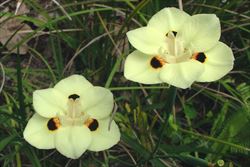Click on images to enlarge

habit (Photo: Sheldon Navie)

strap-like leaves and flowers (Photo: Sheldon Navie)

close-up of leaf showing prominent midrib (Photo: Sheldon Navie)

flowers (Photo: Sheldon Navie)

close-up of flower (Photo: Sheldon Navie)

young fruit (Photo: Sheldon Navie)

immature fruit (Photo: Sheldon Navie)

mature fruit (Photo: Sheldon Navie)

habit (Photo: Sheldon Navie)

strap-like leaves (Photo: Sheldon Navie)

close-up of leaves clustered together at the base of the stems (Photo: Sheldon Navie)

large leafy bract at the base of the branched flower cluster (Photo: Sheldon Navie)

flowering branches with smaller leafy bracts (Photo: Sheldon Navie)

flower bud subtended by two leafy bracts (Photo: Sheldon Navie)

close-up of flower, showing the three petal-like style branches in the centre (Photo: Sheldon Navie)
Scientific Name
Dietes bicolor (Steud.) Sweet ex Klatt
Family
Iridaceae
Common Names
African iris, butterfly iris, dietes, false iris, fortnight lily, peacock flower, Spanish iris, South African butterfly iris, wild yellow iris, yellow flowering wild iris, yellow wild iris
Origin
Native to southern Africa (i.e. Cape Province in South Africa).
Naturalised Distribution
Not yet formally regarded to have become fully naturalised in Australia. However, it has been reported to be growing in bushland in the Sydney region.
Notes
Yellow wild iris (Dietes bicolor) is regarded as a potential environmental weed in New South Wales and Victoria. It is of particular concern in the wider Sydney and Blue Mountains region, where it is reported to be escaping from gardens and amenity plantings into conservation areas (e.g. Lane Cove National Park).

